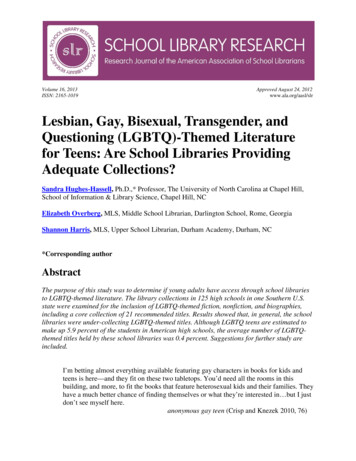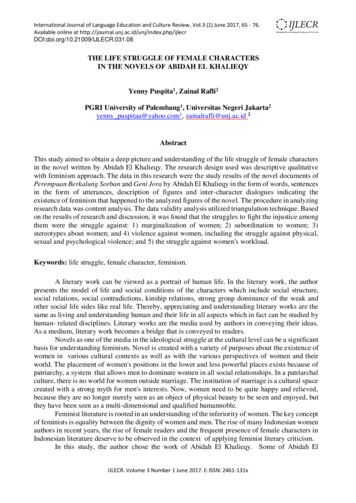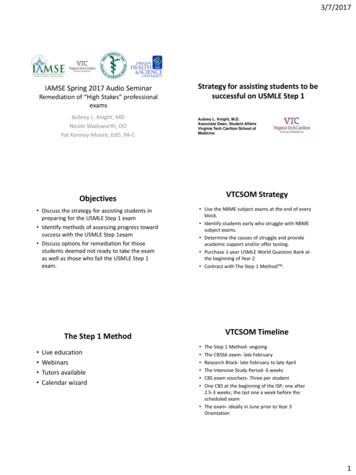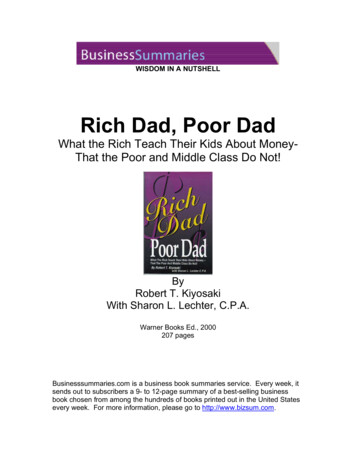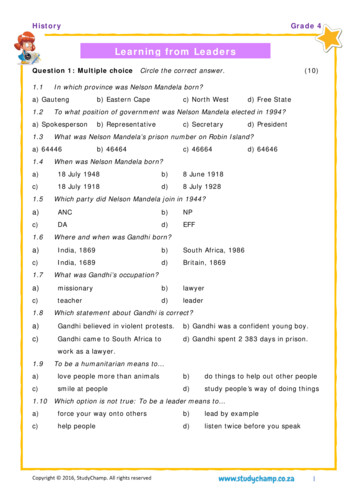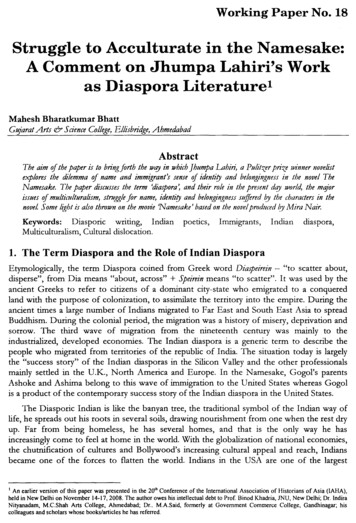
Transcription
Working Paper No. 18Struggle to Acculturate in the Namesake:A Comment on Jhumpa Lahiri's Workas Diaspora Literature!Mahesh Bharatkumar BhattGJ!jarat Arts& Science College, Ellisbridge,AhmedabadAbstractThe aim of the paper is to bringforth the wqy in which Jhllmpa Lahiri, a Plllitzer prize winner novelistexplores the dilemma of name and immigrant's sense of identity and belongingness in the novel TheNamesake. The paper discllsses the term 'diaspora: and their role in the present dt!Y world, the mqjorisslles of mllltimltllralism, stmggle for name, identity and belongingness sJ(fJered0' the characters in thenoveL Some light is also thrown on the movie 'Namesake' based on the novelprodJlced I!y Mira Nair.Keywords:Diasporic writlng, IndianMulticulturalism, Cultural dislocation.poetlcs,Immigrants,Indiandiaspora,1. The Term Diaspora and the Role of Indian DiasporaEtymologically, the term Diaspora coined from Greek word Diaspeirein - "to scatter about,disperse", from Dia means "about, across" Speirein means "to scatter". It was used by theancient Greeks to refer to citizens of a dominant city-state who emigrated to a conqueredland with the purpose of colonization, to assimilate the territory into the empire. During theancient times a large number of Indians migrated to Far East and South East Asia to spreadBuddhism. During the colonial period, the migration was a history of misery, deprivation andsorrow. The third wave of migration from the nineteenth century was mainly to theindustrialized, developed economies. The Indian diaspora is a generic term to describe thepeople who migrated from territories of the republic of Jndia. The situation today is largelythe "success story" of the Indian diasporas in the Silicon Valley and the other professionalsmainly settled in the U.K., North America and Europe. In the Namesake, Gogol's parentsAshoke and Ashima belong to this wave of immigration to the United States whereas Gogolis a product of the contemporary success story of the Indian diaspora in the United States.The Diasporic Indian is like the banyan tree, the traditional symbol of the Indian way oflife, he spreads out his roots in several soils, drawing nourishment from one when the rest dryup. Far from being homeless, he has several homes, and that is the only way he hasincreasingly come to feel at home in the world. With the globalization of national economies,the chutnification of cultures and Bollywood's increasing cultural appeal and reach, Indiansbecame one of the forces to flatten the world. Indians in the USA are one of the largestI An earlier version of this paper was presented in the 20'h Conference of the International Association of Historians of Asia (IAHA),held in New Delhi on November 14-17,2008. The author owes his intellectual debt to Prof. Binod Khadria, JNU, New Delhi; Dr. IndiraNityanadam, M.C.Shah Arts College, Ahmedabad; Dr . M.A.Said, formerly at Government Commerce College, Gandhinagar; hiscolleagues and scholars whose books/articles he has referred.
IMDS Working Paper Seriesamong the groups of Indian diasporas, about 2.5 million. They are well represented in allwalks of life particularly in academia, LT. and medicine.2. Writers of the Indian Diaspora in EnglishLiterature, as a product of culture becomes the source by which we would be awoken aboutthe global scenario and multiculturalism. Good fiction embellishes facts and adds interestinglayers to hold readers' attention and makes people aware about the contemporary society.About the diasporic writing Jasbir Jain says, "Language and cultures are transformed as theycome into contact with other languages and cultures. Diasporic writing raises questionsregarding the definitions of 'home' and 'nation'. Schizophrenia and/or nostalgia are oftenpreoccupations of these writers as they seek to locate themselves in new cultures" Gain, 1998).The creation of literature gives the historical connections in the context of contemporarysocial structure.The first imaginative works that lay the foundation for subsequent narratives of thediaspora is a collection of short stories of Seepersad Naipaul concerned with the lives andstruggle of the Girmit or sugar diaspora. The new diaspora can be exemplified by the uneasyinteraction between gender, class, ethnicity and nation-states. For sugar diaspora, 'home'signifies an end to itinerant wandering in the putting down of roots, while for new (masaJa)diaspora, it is linked to a strategic espousal of rootlessness. Diasporic writing, a post-colonialscenario, elaborates issues such as marginalization, cultural insularity, social disparity, racism,ethnicity, etc. Oscillating between the attractions of home and those from the new, themigrants wage a constant psychic battle: the old world is replete with myth and tradition; thenew world order is proliferate with thirst for freedom and independence. They are in adilemma as to whether they should remain in a ghetto of old values with least interaction withthe majority, or break the barriers and get assimilated with the overwhelming new culture.The writers of the Indian Diaspora like V. S. Naipaul, Salman Rushdie, Amitav Ghosh,Anita Desai, Bharati Mukherjee, Rohintan Mistry, M. G. Vasanji, Bapsi Sidhwa, Kiran Desai,and Jhumpa Lahiri have explored the identity crisis, racial and cultural conflicts, ethnicity,sense of belongingness, loneliness and alienation among the immigrants. The history ofimmigration is the history of alienation and its consequences. For every freedom won, atradition is lost. For every second generation assimilated, a first generation in one way oranother spurned. For the gains of goods and services, an identity gets lost, and uncertaintyfound.Literature should remain the faithful representation of contemporary society. So, it is themoral duty of the diaspora writers to remain faithful while mixing the facts with fiction intheir writings. They would be considered, to some extent the flag bearers of the history oftheir time. Majority of the diaspora writers write about their own experiences, the problemsthat they have to face while settling on the new land.3. Difference between Indian and American CultureIndians may appear to be a homogeneous mass of people, but in reality India is the world'soldest melting pot where the population can be classified and broken down by religion, caste,language and sex. Because of these divisions, ironically, every Indian belongs to a minority38
Struggle to Acculturatein the Namesake:A Comment on Jhumpa Lahiri's Work as Diaspora Literaturegroup. From the day an Indian is born he/ she has to assimilate, thrive and succeed in thisenvironment. When one goes to the U.S. it is an extension of being able to assimilate andsucceed in a different world.But in India, one possesses the ability to disappear into the masses of the city because onedoes not look different from those around him. However in North America's white AngloSaxon environment, one loses that capability and has to prove his worth constantly, especiallyin places where Indians are a rare commodity. Maintaining ties to India and preserving Indiantradition in America meant a lot to them. The idea of melting pot is a metaphor that impliesall the immigrant cultures are mixed and amalgamated at their own place. Most of the fIrstgeneration parents have immigrated to North America to improve their economic status.They look down upon the unbridled individualism of the west and privilege familistic valuesof their own ethnic culture.Diaspora is basically an experience of dislocation and re-Iocation. Indian culture is pluraland fluid. It is the intrinsic plurality and the built-in tolerance of the Hindu system itself thatprovides a matrix where embedding is possible. Several migrant communities like the Parsisand Bahai's etc. have enriched Indian culture at the same time they assimilated into IndianCulture like sugar in the milk. The into-Indian diaspora has made India very resilient.4. Major Issues in Diasporic WritingDiasporic literature, quite like immigrant literature, mirrors a 'double vision', at once of'yearning backward' and 'looking forward'. The peculiarities that we fInd in the NRIs havebeen successfully narrated by the diaspora writers. The following are the major issues in reallife that are discussed by the diaspora writers. The children of the immigrants are called"ABCD" - Amencan Born Confused Desi (usually used as something of an insult). This "inbetween-ness" can leave them with uncertainty about their own role in society - neitherIndian nor American. As the NRIs may adopt foreign culture, it may be a threat to our ownIndian culture. Identity is lost as they are treated as Indian on the foreign land and asforeigner on their motherland. They used to postpone returning to India every year, i.e. NRIsyndrome. Again, they talk ill about India and Indians. Those who return to India after somestay abroad have to face public criticism of leaving the land of opportunity without thinkingabout any adjustment on that land. The immigrant novelist is a teacher who wishes to educatehis fellow natives about the actual nature of colonialism. He wishes to inculcate in them, adeference for their indigenous value system. He is the spokesman who tries to de-mystify hisnatives about the glorifIed white race at the same time suggest to adopt what is best in themlike discipline, cleanliness etc. Dr. M.F. Salat rightly says: "The diaspora as belonging toeverywhere and nowhere at the same time, just like an "unanchored Soul" (pal, 2004).Regarding the diasporic experience, Adesh Pal says, "The fIrst generation has strongattachment with the country of their origin. From the second generation onwards ties withthe homeland gradually gets replaced by those with the adopted country. Food, clothes,language, religion, music, dance, myths, legends, customs of individual community etc.become the markers of identity. These are retained, discarded or adopted differently atdifferent times and places" (pal, 2004).Physical displacement from the motherland may also raise socio-cultural andpsychosomatic identity questions. Cultural cross-currents have led to a hybrid culture and a39
IMDS Working Paper Seriesnew process of cultural assimilation. A mixed cultural milieu opens up new vistas ofcommunication and dialogue in this cosmopolitan world. As a result, diasporic reciprocationhas become one of the recurrent themes in post- colonial world literature.The Writers of Indian diaspora, as William Safran observes: "Continue to relate personallyor vicariously, to the homeland in one way or another, and their ethno-communalconsciousness and solidarity are importantly defmed by the existence of such a relationship"(paranjape, 2001). One of the Major issues pertaining to the Indian Diaspora is how topreserve Indian cultural identity successfully. For that the institution like British council orAlliance Francaise should be appropriately adapted and emulated.5. Biographical Sketch of the Authoress Jhumpa Lahirijhumpa Lahiri (born as name Nilanjana Sudeshna) was born in 1967, in London, and raised inRhode Island. She also has two different names - different on her passport and birthcertificate. She is a graduate of Barnard College, did her M.A. at Boston University, and aPh.D. in renaissance studies. Her debut collection Interpreter of Maladies (1999) won the 2000Pulitzer Prize for fiction. Her first novel The Namesake (2003), a major national best seller, wasnamed the New York magazine book of the year. Unaccustomed Earth, published in 2008, is herlatest collection of short stories.Talking about her own dilemma of name she says in her interview with jeffrey Brown,"It's what my world is, and I've always been aware of my parents came from Calcutta. I havefound myself sort of caught between the worlds of left behind and still clung to, and also theworld that surrounded me at school and everywhere else, as soon as I set foot out of thedoor" (pbs, 2008).jhumpa Lahiri largely writes about the human condition of Indian diaspora in the USA.Her focus is the 'minds cape of characters' and 'human predicament' in its wider perspective.Lahiri delves deep to explain the labyrinths of her characters, to explore, psychologically theintricacies and complexities of human relationships particularly of a class of characters wholive in the west but with parents born and raised in India. What are they? - Indians orAmericans. They had not changed their habits, and they are apparently a close knit ethnicgroup, still far from being assimilated into the general current of life around them. Yet theywere as far from the Indian current. Like the mythological king Trishanku, they stoodsuspended between two worlds, unable to enter either and making a haven of their own.Gogol resembles this situation.6. About the Plot and Various Aspects of the NovelThe novel is the story of two generations of an Indian family and their struggle to acculturatethemselves in the west. In the autobiographical novel, The Namesake, Lahiri tells the story ofGogol Ganguli, the American-born son of Ashoke and Ashima Ganguli, who arrive inMassachusetts from Calcutta in the late 1960s. Regarding the self in the text versus the self astext in Asian-American Autobiographies, Rocio G. Davis says, "Asian Americanautobiographies generally highlight the protagonist's growing comprehension of the meaningor value that society places on questions and attitudes about ethnic differences, historicalreconstruction, and the place of their communities in American societies" (Davis, 2005). We40
Struggle to Acculturatein the Namesake:A Commenton Jhumpa Lahiri's Work as Diaspora Literaturefind the same; to some extent in this novel. The novel begins in 1968 with the birth of a sonto Ashoke & Ashima Ganguli, a Bengali couple setded in Boston. While Ashima is givingbirth, the reader is taken back in time to 1961 when Ashoke almost lost his life in a trainderailment. Only the book he was clutching - A Collection if Nikolai Gogol's Short Stories revealed him to rescuers. With this story in mind, the Ganguli's confront the problem of whatto do with their newborn son's name. He needs both a 'bhalonam' - a good name for theoutside world, and a 'daknam' - a pet name to keep with Bengali tradition. But the lettercarrying the good name never arrives from Ashima's grandmother in Calcutta, so he starts hislife with only his familiar name Gogol. Gogol is admitted to the school under the name ofNikhil but the principal explains that due to their son's preference, he will be known as Gogolin school. When Gogol's sister is born, the Ganguli's are ready with the name, Sonia SonalLIOn Gogol's 14th birthday his father presents him the book 'The Short Stories if NikolaiGogo/', but does not tell about the train accident. Later on, his father tells him the truth ofhim being named so. It has a profound effect on Gogol. Gogol could not assimilate himselfwith the American culture. He loves Ruth, a white American, his college friend, but theirfriendship retained for a short period. His next love is Maxine who is of white Americanethnicity. Their friendship breaks because of Gogol's struggle regarding emotionalcomplications of his father's death. After this, his mother tells Gogol to have friendship withMoushumi, daughter of their friend, due to their shared culture and background. But theirmarriage breaks as Moushumi loves Dimitri, a German man.Ashima, after the death of her husband, decides to live for six months in India and Sixmonths in the U.S.A. At a party on Christmas Eve, Gogol fmds the unread book that hisfather had presented him on his 14th birthday. He turns to read the first story 'The Overcoat'.The novel ends with the ideas in Gogol's mind. "The givers and keepers of Gogol's name arefar from him now . Without people in the world to call him Gogol, no matter how long helives, Gogol Ganguli will, once and for all, vanish from the lips of loved ones, and so, cease toexist. Yet the thought of this eventual demise provides no sense of victory, no solace" (Lahiri,2004).Lahiri pictures the sordid spectacle of racism, prejudice and marginalization by theunwelcoming society and Gogol is a victim of it. This we fmd in the recent migration ofstudents to Australia, Canada and other developed countries. Gogol struggles to transformhimself by escaping from the traditions of the community of Indian immigrants to which hisfamily belongs. He is an ABCD - an American Born Conjimd Desi. Lahiri depicts that theABCD's are unable to answer the question: "Where are you from?" The novel probes into theinner psyche of characters and brings out stirring and teasing sense of identity by clash ofcultures. In the flat world, multiculturalism results in "the Melting Pot" and "Salad Bowl".The novel overflows with the subde grace and dignity of a family forced to make peace withtheir loyalties to India and America.7. Gogol's Predicament for NameContrary to popular idiom "What's in a name?", Gogol is obsessed with "It's everything thatmatters in a namel". His hatred for his name is explained thus: "For by now, he's come tohate questions pertaining to his name, hates having constandy to explain. He hates that his
IMDS Working Paper Seriesname is both absurd and obscure, that it has nothing to do with who he is, that is neitherIndian nor American but full of all things Russians" (Lahiri, 2004).In Indian perception good names represent dignified and enlightened qualities. Pet namesare sometimes meaningless and silly. The title The Namesake reflects the struggle GogolGanguli goes through to identify with his unusual name. About the controversy of name ofGogol, Lahiri says in an interview, "But I think that for the child of immigrant, the existenceof two names kind of speaks so strongly for the very predicament of many children ofimmigrants. On the other hand, the problem for the children of immigrants - those withstrong ties to their country of origin - is that they feel neither one thing nor the other. Thishas been my experience, in any case. For example, I never know how to answer the question:"Where are you from?" If I say I'm from Rhode Island, people are seldom satisfied. Theywant to know more, based on things such as my name, my appearance, etc. Alternatively, if Isay I'm from India, a place where I was not born and have never lived, this is also inaccurate.It bothers me less now. But it bothered me growing up, the feeling that there was no singleplace to which I fully belonged" (Book Browse, 2007).After changing the name, there is only one complication: "He doesn't feel like Nikhil. Notyet. But after 18 years of Gogol, two months of Nikhil feel scant, inconsequential" (Lahiri,2004). Gogol is not completely cut off from his roots and identity. He tries to reject his pastbut it makes him stranger to himself.8. Theme of Cultural DislocationToday's fiction celebrates hybridity. The social upheavals and the terrible delusions of modemtimes have been presented in nearly all novels that are being written today. These novels havea universal appeal cutting across barriers of culture and time. We are all socialized differentlybecause we come from different cultural backgrounds and we grow up in differentcommunities. But at the core of every culture remains the uploading of basic human values. Aglobalised culture has now evolved and it must combat with the world of heterogeneoussocieties who do not wish to leave aside their historical particulars which give themuniqueness. Certain elements constitute markers of identity - food, clothes, languageretention, religion, music, dance, myths, legends, customs, individual community, rites ofpassage and others. These are retained, discarded or adopted differently at different times andplaces; but a feeling of oneness, a tug of the roots persists even after several years andsometimes centuries.Writers who are cultural hybrids like Maxine Hongkinstun (Wamor Woman), Gloria Naylor(Gye Bailry), Alice Walker (Colour Puple), Bharati Mukerjee (The Holder of the World),lhumpaLahiri and many others are taking up issues like identity crisis, nationalism, alienation,marginalization, insider outsider, hegemonic power discourses in the fiction that they arewriting today. Critic Stuart Hall says, "There are at least two different ways of thinking about'cultural identity'. One is in terms of shared culture, a sort of collective . the second one iswhat we really are, or rather - since history has intervened - what we have become .Cultural identity in this sense is a matter of becoming as well as of being. It belongs to thefuture as much as to the past. Cultural identities . undergo constant transformation"(Dodiya,2006).42
Struggle to Acculturate in the Namesake:A Commenton Jhumpa Lahiri's Work as Diaspora LiteratureRegarding hyphenated identity Meena Alexander, a diasporic woman writer, has identifiedherself as having serious problems in America. She writes in Fault Lines, "In America youhave to explain yourself constantly. It's the confessional thing. Who are you? Where are youfrom? What do you do? I try to reply. As much as anything else I am a poet writing inAmerica, but American poet? What sort? Surely not Robert Frost or Wallace Stevens variety.An Asian-American poet then? Clearly that sounds better" (Alexander, 1993).In Lahiri's novel The Namesake the role of memory in a process of change is often used bythe writer in an effective way. It is through the eyes of the first generation settlers that thesecond generation learns about the homeland. Cultural displacement involves the loss oflanguage, family ties and a support system. Lahiri stresses culture and its importance inimmigrant experience with a humanist outlook. Narrating the immigrant experience inAmerica she consciously foregrounds the merits of native culture and the mysteries ofacquired culture probably experienced in the process of her own self- acculturation. The lossof roots, language and social norms are the three most important parts of the definition ofwhat it is to be human being.For the second generation the question of identity is a complicated issue. At home Indianculture and value system are adhered to, while in public the American code of conduct isfollowed. All first generation settlers want their children to do well and get good jobs. TheAmerican dream looms in their eyes and they want their children to exploit the situation andderive maximum benefit for themselves, but they must follow the Indian moral and culturalcode at home. Ashima and Ashoke try hard to hold on to their Indian-ness, their culturedespite surrounded by the American culture all around. They go at the Kathakali danceperformance or a Sitar recital at memorial hall. When Gogol is in third grade, they send himto Bengali language and culture lessons every other Saturday, held in the home of one of theirfriends. But, Gogol, Sonia, and Moushumi want to chart their own lives. The secondgeneration immigrants are not attached to their cultural past, infact; they find it easier toaccept America's hybrid culture. Both Gogol and Sonia grow in suburban New York andchoose American over their Bengali culture, which is not liked by their parents. Upon Gogol'sgraduation the family goes on a trip to Calcutta, as they enter India, "There are endless namesGogol and Sonia must remember to say, not aunt this and uncle that but terms far morespecific: mashi and pishi, mama and maima, kaku and jethu, to signify whether they are related ontheir mother's or father's side, by marriage or by blood" (Lahiri, 2004). Googol's shifting inwith Maxine is an assertion of his independence, and his desire to completely merge with theAmerican culture. Gogol eventually marries Moushumi, but they are not happy and so theypart. Gogol is schizophrenic as he is split/tom between two nations, India/ America, betweentwo names, Indian/Russian, between two value systems, traditions/conventions. Geneticallyhe is tied up to his traditions and has unique self; racially he is alien, and a second class citizenin America. He feels that his wife has a better status. His complexes get reflected throughMoushmi, who feels dissatisfied having married him.For Ashima, motherhood in a foreign land is much severe for her. She could not forgether relatives in India and continuously longs for them. "For being a foreigner, Ashima isbeginning to realize, is a sort of life long pregnancy - a perpetual wait, a constant burden, acontinuous feeling out of sorts. It is an ongoing responsibility, a parenthesis in what had oncebeen ordinary life, only to discover the previous life has been vanished, replaced by somethingmore complicated and demanding" (Lahiri, 2004). Ashima experiences that "Americans, in43
IMDS Working Paper Seriesspite of their public declarations of affections, in spite of their miniskirts and bikinis, in spiteof their hand-holding on the street and lying on top of each other on the CambridgeCommon, prefer their privacy" (Lahiri, 2004). Ashima's love of family influences her to createa close-knit web of immigrant friends. This group practices Indian custom, speaks the Bengalilanguage, and, in many respects, becomes a substitute family for the vast collection ofrelatives back in India. But for Ashima, the close relations between the immigrants become anexcuse to avoid the customs of American life. For Ashima and Ashoke, the question ofdisregarding their elder's wishes is impossible whereas the situation reverses after a few yearswhen their children follow the American tradition. Ashima is reluctant to learn to drive, sheinsists on wearing Indian clothing and eating Indian food, and for many years she liveswithout American friends. To a large degree, her life is consumed by recreating Indian culturein America. After the death of her husband Ashoke, after the divorce of Gogol and afterSonia decided to marry Ben, Ashima decides to stay for six months in Calcutta and sixmonths in America. She is overcome by a feeling of being dis-housed, not knowing where shereally belongs. Her struggle for acculturation and her fInal decision or solution to it is foundat the end: "She feels lonely suddenly, permanently alone . she feels overwhelmed by thethought of the move she is about to make, to the city that was once home and is now in itsown way foreign . For thirty-three years she missed her life in India. Now she will miss herjob at the library, the women with whom she worked. She will miss throwing parties . Shewill miss the country in which she had grown to know and love her husband" (Lahiri, 2004).Ashoke wants to provide a better life for his newly born son by earning a doctoratedegree from a prestigious American university. In naming his son, he pays the greatesthomage to western culture because Gogol is a representative of European high culture. As auniversity professor Ashoke is accepted into the academic community - but at home hecontinues to be the traditional Indian male, fastidious about his clothing and food. ForAshoke, memories of life in India are less peaceful. The memories of that fateful nightinfluence him to leave India and ultimately lead him to choose an unusual name for his son.Still, Ashoke, like his faithful wife, embraces his past in India and recognizes that it plays asignifIcant role in his life as a father and an American.Gogol: If Ashima and Ashoke make peace with their pasts, however, their son, Gogol,spends much of the novel attempting to eradicate his heritage. This fIrst becomes evidentwhen Lahiri describes how Gogol and his sister resent childhood trips to India during whichthey are forced to interact with family and give up the material comforts of American life. Thenovel depicts the cross-cultural issues of not getting assimilated with the culture of Americafor Ashima and Ashoke, at the same time their children could not adjust themselves duringtheir visits to India. Gogol does not want to go to Kindergarten as his parents told him that atschool, instead of being called Gogol, he will be called by a new name, Nikhil, a good name.As Gogol grows older, his desire to escape his own past becomes more pronounced. When itcomes time to apply for college, for instance, Gogol turns his back on his father's alma materand accepts a position at Yale. While in college, meanwhile, he refuses to study an"acceptable" immigrant subject like chemistry, engineering, or biology, preferring instead topursue an interest in architecture. Such actions not only neglect the wishes of his parents, butalso serve as a reminder that Gogol is uncomfortable with his upbringing. Unlike his parents,Gogol does not see himself as a stranger living in a foreign land. He wants to be seen asAmerican. Gogol's rebellion against his past reaches a crescendo the summer before he leaves44
Struggle to Acculturatein the Namesake: A Commenton Jhumpa Lahiri's Work as Diaspora Literaturefor college. One day Gogol attends a panel discussion about Indian novels written in English.He is bored by the panelists who keep referring to something called "marginality". When thesociologists on the panel talks about ABCD, Gogol thinks the word Confused to be replacedby conflicted. He knows that Deshi, a generic word for "countryman", means "Indian", but henever thinks of India as Desh. He thinks of it as Americans do, as India.Lahiri skillfully blends events of the past into events of the present. She allows readers tolive the moments along with her characters as the past becomes present - the present, past.Yet Gogol's inability to shake his own past is most evident in his relationships with women.In his early romances, he is careful to avoid any contact with his past or upbringing. India israrely discussed, and his girlfriends are not allowed to meet his parents. With one womannamed Maxine, in fact, Gogol attempts to become an entirely different person. He adoptsMaxine's carefree lifestyle. He listens to Maxine's mu
Struggle to Acculturate in the Namesake: A Comment on Jhumpa Lahiri's Work as Diaspora Literature group. From the day an Indian is born he/ she has to assimilate, thrive and succeed in this environment. When one goes to the U.S. it is an extension of b



